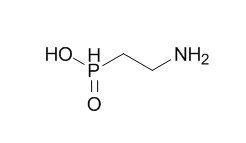(2-Aminoethyl)phosphinic acid
The specific growth rates of C. raciborskii cells in media treated with β-glycerol phosphate, d-glucose-6-phosphate, and (2-aminoethyl)phosphinic acid are significantly higher than those of cells grown in phosphorus free media.
Inquire / Order:
manager@chemfaces.com
Technical Inquiries:
service@chemfaces.com
Tel:
+86-27-84237783
Fax:
+86-27-84254680
Address:
1 Building, No. 83, CheCheng Rd., Wuhan Economic and Technological Development Zone, Wuhan, Hubei 430056, PRC
Providing storage is as stated on the product vial and the vial is kept tightly sealed, the product can be stored for up to
24 months(2-8C).
Wherever possible, you should prepare and use solutions on the same day. However, if you need to make up stock solutions in advance, we recommend that you store the solution as aliquots in tightly sealed vials at -20C. Generally, these will be useable for up to two weeks. Before use, and prior to opening the vial we recommend that you allow your product to equilibrate to room temperature for at least 1 hour.
Need more advice on solubility, usage and handling? Please email to: service@chemfaces.com
The packaging of the product may have turned upside down during transportation, resulting in the natural compounds adhering to the neck or cap of the vial. take the vial out of its packaging and gently shake to let the compounds fall to the bottom of the vial. for liquid products, centrifuge at 200-500 RPM to gather the liquid at the bottom of the vial. try to avoid loss or contamination during handling.
J Nat Med.2017, 71(2):380-388
Heliyon.2024, 10(11):e32352.
Life (Basel).2021, 11(12):1399.
Phytother Res.2015, 29(7):1088-96
Chem Pharm Bull (Tokyo).2019, 67(11):1242-1247
J Ethnopharmacol.2019, 236:31-41
Drug Des Devel Ther.2020, 14:969-976.
Biomol Ther (Seoul).2024, 32(2):214-223.
J Sci Food Agric.2023, 103(1):213-220.
Pathol Res Pract.2024, :260:155445.
Related and Featured Products
Harmful Algae, 2014,39 :112-20.
Dissolved organic phosphorus use by the invasive freshwater diazotroph cyanobacterium, Cylindrospermopsis raciborskii[Reference:
WebLink]
This study examines the physiological responses of the diazotrophic cyanobacteria, Cylindrospermopsis raciborskii, to different dissolved organic phosphorus (DOP) compounds to explore mechanisms of environmental acclimation in this invasive species.
METHODS AND RESULTS:
Our results show that the specific growth rates of C. raciborskii cells in media treated with β-glycerol phosphate, d-glucose-6-phosphate, and (2-Aminoethyl)phosphinic acid were significantly higher than those of cells grown in phosphorus free media. We observed that maximal net photosynthesis was highest when cells were cultured with d-glucose-6-phosphate and lowest when cells were cultured with glyphosate. Similarly, rates of photosynthetic activity (maximum quantum yield, maximum electron transport rate, and photosynthetic efficiency) were observed to be highest in media treated with d-glucose-6-phosphate. We report that rates of alkaline phosphatase activity to the different organophosphates tested changed markedly in response to the concentration of dissolved inorganic phosphorus (DIP); a result supported by the amount of green fluorescent products revealed by ELF®97 phosphate dye (ELFP) and gene up-regulation for alkaline phosphatase (phoA). Our results indicate that C. raciborskii is able to use different organic phosphorus to support its growth when phosphorus is limited. In addition, we show that C. raciborskii has a higher availability to phosphate (COP) than phosphonate (CP).
CONCLUSIONS:
The results suggest that the strategic flexibility to environmental phosphorus might play an important role in the domination of C. raciborskii.



